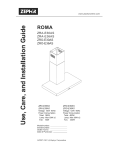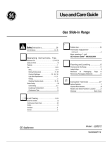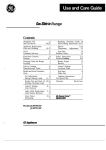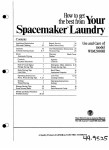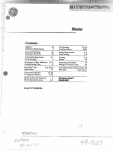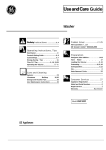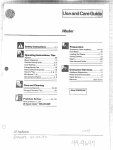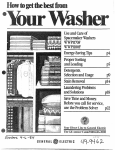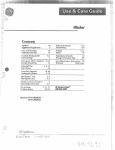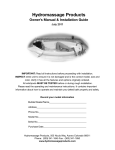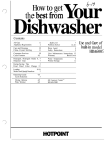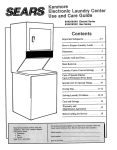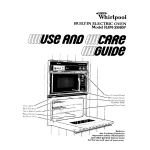Download GE WWA8800M User's Manual
Transcript
Contents ~~~ Agitator Appliance Registration Bleach Dispenser Care and Cleaning Consumer Services Controls Setting Guide 26 2 Problem Solver Safety Instructions 8 26 Soak Setting Sorting 27 47 Stains Stain Removal Guide ~~~ Energy-SavingTips Filter-Flo@Pan 10 4, S,9.26 Warranty Hard Water Limestone Deoosits 16 14.26 Loading the Washer Tub Mini-Basketm 4,12 9 Model WWASSOOM c 4.5 ~~ 26 User Maintenance Instructions 26 Cover Back 5.9 2 7, 18 19 ~~~ ~~~ Storage & Vacation Tips Operating Instructions Pie-treatiiig 17 11, ,. 598 4.11 Cycle Settings 5 Detergents, Other Additives 13-17 Mini-QuickCycle Model and Serial Numbers 20-25 394 GE- btw@ m@Um# Help us help you. . Read this book carefully. It is intended to help you operate and maintain your new washer properly. Keep it handy for answers to your questions. If you don’t understand something or need more help, write (include : your phone number) Consumer Affairs GE Appliances Appliance Park Louisville, KY 40225 If you receiveda damaged washer.. . Immediately contact the dealer (or builder) that sold you the washer. Save timeand money. . Before you request service.. check the Problem Solver on pages 20-25. It lists causesof minor operating problems that you can correct yourself. Write down the model and serial numbers. You’ll find themon a label on the lower left side near the front. These numbersare also on the Consumer Product Ownership Registration Card that came with your washer. Before sending in this card, please write these numbers here: Model Number Ifyou need service q To obtain a Spanish language version of this book, call GE AnswerCenteP 800.626.2000 consumer information service. Para obtener la versi6n en manual, espaiiol de este llame a GE AnswerCentefl servicio de informaci6n para el consumidor, teldfono 800.626.2000. FOR YOURSAFETY If you smell gas: 1. Open windows. 2. Don’t touch electrical switches: 3. Extinguish any open flame. 4. Immediately call your gas supplier. ‘Don’t turn electric switches on or off because sparks may ignite the gas. FOR YOURSAFETY Do not store or use gasoline or other flammable vapors and liquids in the vicinity of thisor any other appliance. Serial Number Use these numbers in any correspondenceor service calls concerning your washer. All washing instruction terms this in book conform to the Care Labeling 1984. Rule establishedby the Federal Trade Commission, January 2 To obtain service, see the Consumer Services page in the back of this book. We’re proud of our service and want you to be pleased.If for some reason you are not happy with the service you receive, here are three steps to follow for further help. FIRST,contact the people who serviced your appliance. Explain why you are not pleased. In most cases, this will solvethe problem. NEXT, if youare still not pleased, write all the details-including your phone number-to: Manager, Consumer Relations GE Appliances Appliance Park Louisville, Kentucky40225 FINALLY, if your problemis still not resolved, write: Major Appliance Consumer Action Panel 20 North Wacker Drive Chicago, Illinois 60606 ’V To minimize the possibility WARNINGTOreduce the risk of fire, electric shock,or injuryto of injury: personswhen using your appliance, Do not mix chlorine bleach with follow basic precautions, including ammonia or acids such as vinegar the following: and/or rust remover. Mixing can Use this appliance only for its produce a toxic gas which may intended purpose as described in cause death. this Use and Care Book. Do not washor dryarticles This washer must be properly that have been cleaned in, washed installed and located in accordance in, soaked in, or spotted with with the Installation Instructions combustibleor explosive substances before it is used.If you did not (such as wax, paint, gasoline, receive an Installation Instructions degreasers, dry-cleaning solvents, you can sheet with your washer, kerosene, etc.) which may ignite obtain oneby contacting the service or explode. location nearestyou. Do not add these substances the to wash water,and do not use these -Properly ground to conform substances around your washer with all governing codesand and/or dryer duringoperation. ordinances. Follow details in Installation Instructions. WARNIN/*G-HYDROGEIVGASis produced by the chemical action -Install or store where it wil not within your water heater and the - ? exposed to temperatures below gas can accumulate in the water lreezing or exposed tothe weather. heater and/or water pipes if hot -Connect to a properly rated, water has not beenused for a protected and sized power supply period of two weeksor longer. circuit to avoidelectrical overload. HYDROGENGAS CAN BE -Connect to adequate plumbing *EXPLOSIVEUNDERTHESE and drain facilities as described in CIR~~CES.~topreven the Installation Instructions. the possibility of damage or injury, if you havenot used hot waterfor Turn off water faucets when the washer is not in use to relieve two weeksor more, or move into a pressure on hoses and valves,toand residence in which the hot water system may not have been used for minimize leakage if a or hose valve some time, turn on aU hot water should breakor rupture. faucets and allow themto run for When disconnecting this several minutesbefore usingany appliance pullby the plug rather electrical appliance which is to avoid damage to the than the cord connected to the hot water system. cord orjunction of cord and plug. T h i s w l i allow any hydrogen gas Make sure that the cord is located so to escape. Since the gas is that it will not be step$ en,tripped flammable, do not smokeor use over or otherwise subjected to an open flame or appliance damage or stress. duringthispmess. *Donotrepairorreplaceanypart Never reach intowasher while of the appliance or attempt any it is moving. Before loading, Ticingunlessspecifically unloading or adding clothes, push llCOmmendedinthisUseandCare in the Cycle Selectorknob to Bookorinpublisheduser-repair “SMIPn position, then wait until instructions that you understand themachinehascompletely and have the skillsto carry out. stopped before opening the lid. 3 Close supervision is necessary if this appliance is usedby or near children. Do not allowchildren to play inside, on or with this appliance or any discarded appliance. Disposeof discarded appliances and shipping or packing materials properly. Before discardinga washer, or removing from service, remove the washer lid. Keep all laundry aids (such as detergents, bleaches, fabric softeners, etc.) outof the reach of children, preferablyinalockedcabinet.Observe to all warnings on container labels avoid personal injury. Keep the area around and underneath your appliances free fmm the accumulation of combustible materials, suchas lint, paper, rags, chemicals, etc. Keep the floor around your appliances clean and to dryreduce the possibility of slipping. To minimize the possibility of electric shock, unplug this .appliance from the power supply t before attempting any maintenance or cleaning (except the removal and cleaning of the lint filter). NOTE: Turning the Cycle Selector knob to an OFF position doesNOT disconnect the appliance from the power supply. Do not tamper with controls. Do not operate this appliance if it is damaged, malfunctioning, partially disassembled, or has missing or broken parts, including a damaged cord or plug. Never climb on or stand on the washer top. Do not wash fiberglass articles in your washer. Skin irritation could result from the remaining particles that may be picked upby clothing during subsequent washer use. Important Safety Instructions(continued) The laundry process can y flame reduce the of fabrics. To avoid such a result, the garment manufacturer's care instructions should be followed very carefully. For washer operation Do not leave washer lid up during cycle. This will stop the wash andspin action andprevent completion of the cycle. SAVETHESE INSTRUCTIONS How to operate your clothes washer WARNING-To reduce therisk of fire, electric shock, or injury to persons, read the IMPORTANT SAFETY INSTRUCTIONS before operating this appliance. Eight Cycle Two Speed Washer wrrh Mmr Wash t Sorting and Loading * Sort clothes carefullyby fabric type, weight, color and amountof soil according to instructions on page 11. 0 Remove Filter-Flo@ pan and Mini-Basket". The underside of the lid is a good place to put the pan while loadingor unloading clothes. LARGE: Over2/3's full. MINI-BASKET: See instructions on page9. Position the Filter-Flo pan on the agitator. Lint will collectin the pan for easy removal when the wash is finished. NOTE: Do not use the Filter-Flo pan as awash basket. Do not put any items tobe washed in the Filter-Flo pan. See page 8 for informationon how to use Bleach Dispenser. For information onhow to use bleaches and fabric softeners, see page17. Close thelid. Washer will fill but not agitate or spin with the lid open. Setting the Controls Do not use Mini-Basket tub when washing regular loads. You'llfind complete details onhow and when to use the Mini-Basket tub on page 9. Use the Controls Setting Guide on pages 6 and 7 to helpyou make the proper selections. Add measured amountof detergent. See pages 13 through 17 for information on detergents and other additives. SMALL: Washer is less than 1/2 full of clothes. MEDIUM: Between 1/2 and 2/3 full. 0 Select Wash and Rinse Temperature. 0 Push Cycle Selector Knob in and turn clockwise to your selected wash setting. Regular Cyciesautomatically provides Normal Wash Speed and Normal Spin Speed. Prrmanent Press and Knits CycleAutomatically provides Gentle Wash Speed and Gentle SpinSpeed. r I 0 Select Water Level * Load clothes into thewash basket being careful not to overload. Clothes shouldbe below the retaining ring. See page 12 for more loading information. I STOP I I 0 Pull Cycle Selector Knob out to start the washer. If you wish to changesettingafterwasherhas started, push Cycle Selector Knob ;- v,, r+,,n tho 1. -. ' F', <."t *,. tne new POSIIIOII. X L L A U ~ can IX changed at any time. 4 Tips to Help You Select Settings I I I I C i g u l a r cyclesFor mostcottons, linens and work and play clothes. Three soil level settings are provided, but you can set the selector in-between, if desired. Selection of these settings automatically provides for Normal Speed Wash, Fast Spin. Mini-Quick CycleFor small, lightly soiled loadsyou need ina hurry. Use with MINIBASKET''' tub only. Regular Cycles Extra Clean Cycle- Soak CydeUse with most soaking aids to loosen embeddedsoils and stains. See page 9. For modem fabrics withheavy or oily soil. A second rinse is provided to help remove the additional detergentthat is required for these soils. , ana I n l a &yer.r 0 Mini-Puick Cycle What Happens in Each Setting (Approximate Minutes) water pressure and your selected water level. 5 Permanent Press and Knits cyclesFor polyester knits, delicates and permanent press.An extended cooldown spray rinse is provided to minimize the setting of wrinkles. Selection of these settings automatically providesfor Gentle Speed Wash, Slow Spin. Controls SettingGuide for different fabrics and loads Load Wash Water Temperature Cycle Cycle Setting cottons andLinens WhitelColorfast BrighVNon-colorfast Hot or Warm Warm or Cold Regular Cycles Regular Cycles Normal or Light Soil Setting Normal or Light Soil Setting Work Clothes Heavy soil Average soil Permanent Press,Treated Cottons, Blends with Cottons Heavy or oily soil Average or light soil Hot Hot or Warm Extra CleanCycle Regular Cycles Set at Start Normal Setting Hot Warm Extra Clean Cycle Set at Start P.Press or Knits Setting Synthetics-Polyester, Nylon, Acrylic Knits and Woven Fabrics sturdy Warm Delicates Silks, Wools; Blends of Silk and Wool Permanent Press and Knits Cycles Permanent Press and Knits Cycles Permanent Press and Knits Cycles Warm Permanent Press and Knii Cycles Permanent hess and Knits Cycles Warm Rayon and Acetate Dawn-filled garments, ifmachine washing is recommended Permanent Press and Knits Cycles Warm P. PreSetting ss Knits Setting Knits setting Knits Setting P.Press Setting -3: .- :"ns\ ~~ Baby Clothes-Sturdy, such as Diapers, Nightgowns, Shirts, Pads, Sheets, Receiving Blankets, Coveralls Hot Regular Cycles Normal or Light SoilW i n g Baby Clothes-Delicate Warm Permanent Press and Knits Cycles Knits Setting Blankets-Mol, Part-Wool, Cotton Warm Regular Cycles 5 min. soak then Light Soil Setting Blankets-Synthetic, Electric Warm Regular Cycles 5 min. soak then Light Soil Setting Curtains-DO NOT MACHINE WASH FIBERGLASS Hot or Warm Normal Soil Setting Chenille Bedspreads,Robes** Hot or Warm Permanent Press and Knits Cycles Permanent Press and Knits Cycles Hot or Warm Regular Cycles Cold or Warm Regular Cycles Normal or Heavy Setting, depending on amountof soil Normal or Light Soil Setting ~ P. Press Setting ~~~ Slipcovers, Draperies, Bathmats and Rugs** Denims (especially IndigoBlue Jeans) and other fabrics thatbleed A Rubber-coated Items, Laminated Fabrics, Vinyl, Plastics and Articles with Plastic Trim Warm Pillows 6 Permanent Press and Knits Cycles P. Press or Knits Setting Permanent Pressand Knits Cycles P. Press or Knits Setting Refer to Garment Manufacturers’ Care Labels - . 1 Bleach Special Instructions I Liquid chlorine type. Only non-chlorine bleach when needed. If colorfast is unusually soiled, usehot water. Use maximumdetergent recommended on page 15. Use Extra Clean Cycle, Large or Small Setting, depending on load size. See page 5. White or colorfast, liquid chlorine type. Non-colorfast, only non-chlorine bleach when needed. Use maximum detergent recommended inguide on page 15. White or colorfast, liquid chlorine type. Non-colorfast, only non-chlorine bleach when needed. Small loads reduce wrinkling. Use maximum detergent recommended in guide onpage 15. Use Extra CleanCycle-see page 5. White or colorfast, liquid chlorine type. Non-colorfast, only non-chlorine bleach when needed. If unusually soiled, use hot water. Use maximum detergent recommended in guide on page 15. For heavy or oily soil on sturdy garments, use Extra Clean Cycle, Large or Small Setting depending on load size-see page 5. Small loads reducewrinkling. No bleach Wash only if recommended by the garment manufacturer. Follow instructions carefully. Seldom needed. If needed, use only non-chlorine bleach. Wash in your washer only if recommended by the garment manufacturer. No bleach Wash frequently to fluff up thedown and retain the garment’s warmth. Wash separately. Wet down gives off an odor that may be absorbed by other garments. Odor disappears when garment is dry. Treat heavily soiled areas with liquid detergent or paste made of water and granular detergent. Close zippers.Wash 2 or 3 at a time or add towels to balance. GARMENT MUST BE TUMBLE DRIED. You may prefer to use a mild-type detergent. Do baby clothes separately. Pretreat spots. Rinse diapers, nightgowns, pads andsheets after use. Keep diapers ina covered pail of cold water and conditioning agent, like Borateem brand. - White or colorfast, liquid chlorine type. - Only non-chlorine bleach when needed. You may prefer to use a mild-type detergent. Do hand-knit garments by hand. No bleach White or colorfast, liquid chlorine type. Fill washer, add detergent, allow to dissolve before adding blanket. Do oneblanket at a time. Pretreat heavily soiled spots with liquid detergent. On electric blanket, sew a strong pieceof cloth over plug to protect blanket and washer from damage. Do one blanket at a time. Pretreat heavily soiled spots with liquid detergent. Vacuum out loosedirt before washing. White or colorfast, liquid chlorine type. If unusually soiled, use Regular Cycle (Normal Speed) Wash and Spin. White or colorfast, liquid chlorine type. Wash only 2 or 3 rugs or mats at one time. Shake before washing to remove excess dirt. No bleach For new “indigo blue” jeans, wash at least 3 times invery small loadswith full water fill. Jeans need ample mom to move to avoid white lines at creases. May discolor plastic washer parts. Subsequent washings will reduce discoloration,but will probably never eliminate it. The stained parts will not discolor subsequentwashing loads. Tumble on FLUFF (No Heat). - No bleach - No bleach I - .I No bleach Pillows are madeof different materials-dacron, fiber, foam, polyester, natural feathersand down. Many pillowscan be machine washed, but manufacturers’care labelsmust be followed curefilly If washing is recommended, check pillows for weak seams o r holes and mend to prevent escape of feathers or filling. Fill washer, add detergent and agitate for several minutes to dissolve detergent. Add two pillows at a time to balance load,use high water level. For more information on care labeling, send for “What’s New About CARE LABELS:’ For sale by the Superintendent of Documents, U.S. Government Printing Office, Washington, D.C. 20402. 7 How to use theBleachDispenser How to use the Filter-Flo@ Pan How to use the Soak Cycle I I Regular Cycles LIGHT SOIL NORMALe Use this dispenser with liquid bleach only. If you prefer to use powdered bleach, pour it into the wash basket along with your detergent. Do not put powdered bleach intothe bleach dispenser. Measure bleach carefully. Here are some recommended amounts: LARGE WASH-1 % cup (310 ml) liquid SMALL WASH-2/3 cup (170 ml) liquid MINI-BASKET tub- ‘A CUP (60 ml) liquid “SOAK CYCLE” temperature will automatically becold. The Filter-Flo pan has two functions: If a hot or warm soak is desired, set the WASHRINSE TEMPERATURE switch to “HOT/COLD’ or “WARM/COLD” and turn the Cycle Selector Knob to “Normal” in the Regular Cycles. Start thewasher. After washerfills and begins to agitate, push in the Cycle Selector Knob and turn to “SOAK CYCLE? Pull out the Cycle Selector Knob to complete the cycle. LINT FILTER-Position the Filter-Flo panon the agitator after loading clothes into the washer. Lint is easily seen and removed after the wash is finished. For an extended soakallow the washer to fill and agitate fora few Pour measured amount ofliquid bleach directly into bleach dispenser. minutes to dissolve thesoaking agent. Then push in the Cycle Selector Do not overfill or allow dispenser Knob to stop the washer (keep lid to overflow. Avoid splashing. closed) andallow to soak foras long as Undiluted bleach can cause fabric desired. After desired soak period, damage. pull out the Cycle Selector Knob to completethe cycle. Never pour undiluted liquid bleach directly onto clothes or Do not use the Mini-Basket tub into the wash basket or Miniwith the Soak cycle. Basket tub. 8 LID FOR THE MINI-BASKETAfter loading theclothes in the Mini-Basket tub, besure to replace the Filter-Flo pan. The pan serves as a lid to keep theclothes in the Mini-Basket tub. NOTE: Do not use theFilter-Flo p . as a wash basket. Do not put any items to be washed in theFilter-Flo pan. Do not place detergent packets in the Filter-Flo pan. 2. How to use the Mini-Basket" tub rhe Mini-Basket'" tub, designed for small loads of regular fabrics or delicate hand-washables, can be used with any cycle except the SOAK cycle. 7. Close lid and set controlsas 4. Load clothes in Mini-Basket tub. See page11 for sorting help. follows: MEDIUM Typical Mini-Basket" tub wash loads SMALL Stuffed toys. 5. After loading clothes in the Mini-Basket tub, besure to replace the Filter-Flo pan. The pan serves as a lid to keepthe clothes in the Mini-Basket tub. Tennis shoes. 6. Add bleach, if desired. Measure How to wash small a load of regular fabrics or delicate hand-washables MINIBASKET Small loads of regular fabrics (up to2 95 pounds). Delicate loadssuch as lingerie, panty hose, girdles, blouses, sweaters, socks, shirts, baby clothes and other small, delicate hand-washables. .6s. -Set Water Level to "MINIBASKET" position. -Select desired Wash/Rinse Temperature. See page4. 8. Pull Cycle Selector knob out to start washer. carefully and pour recommended amount of liquid bleach-114 cup (60 m1)-directly into the bleach dispenser. See page8 for dispenser instructions. How touse the "I-QUICK cycle The MINI-QUICK cycle is a short cycle intended to wash small loads of lightly soiled clothes you need in ahurry. 1. Remove Filter-Flo@ pan. -\ Because this cycleis a short one for smallloads, the Mini-Basket tub shouldbe used for satisfactory results. 1 1. Follow all the steps above and at aleft except for cycle selection. \ and Knits Cycles 2. Place Mini-Basket tub on agitator. Pull the agitator towardthe front of the machine for easier installation and removal of Mini-Basket tub. 3. Put 1/4 to 1/3 cup(60 to 80 ml) detergent in the bottom of the MiniBasket tub. 1 Special instructions for useof the Mini-Basket" tub The Mini-Basket tubcan be used with any cycle except the SOAK cycle. When using the MINI-QUICK cycle, the Mini. Baskettubshouldbeused. '4u and Do not wash clothes inthe regular wash basket when usingthe Mini- I Extra Clean Cycle ~ I Basket tub. There will not be enough water in the regular basket and clothes damage could result. When washing stockings, panty hose tangled other easilv items, always handldsepirately. To minimize tangling, the use aofnet laundry bag is recommended. 9 2. Push the Cycle Selectorknob in and turn it clockwise to the MINIQUICK cycle. 3. Pull the Cycle Selector knob to start the washer. Energy-Saving Tips If your clothes and household items don't look cleanand fresh after washing, you will probably re-wash them.. .and that means you'll waste energy. Remember to sort your clothes carefully, and load them properly, select correct cycles, use enough detergent andchoose a water temperature warm enough to release and get rid of soil. Use Hot Wash-up to 150°F.-on washing heavily soiled articles-such as work and playclothes. a regular basis only when Under normal soil conditions, wash in water above80°F. (27°C.). This generally means using the Warm Wash temperature setting on your washer-temperatures approximately 90"to 110°F. or hand comfortable. If you notice that soil has accumulated after several consecutivewashings, use Hot Wash occasionally, if safe for fabrics. Try to washless often.Save articles of the same typeof fabric until you havea full load. If you must washsmaller loads, adjust the amountof water. Small loads shouldhave lower water levels. Wash in off-peak utility hours. Your local utility can tell you which are the off-peak hours. Use Normal Spin Speed to remove more water and helplessen drying time. The dryer will remove any wrinkles causedby the Normal Spin. Use your Mini-Basket'" tub for very small loads. It uses less water than the small water level in the big tub on this washer.You will also save on detergent and energy. 10 How to sort the clothes ’ Qortby surface texture Sort by soil Separat Separat w w Producers Lightly Soiled from from Medium Collectors LINT PRODUCERS- Such as terry toweling and chenille-give up lint. LINT COLLECTORS- such as man-made fibers and napped fabrics like velveteen and corduroy -attract lint. These must be washed separately. For moreinformation on lint control, see page20. from A thorough soaking with detergent or special soaking agentis another way to remove heavysoils, embedded dirt and even some stains. Sort by - color Separa I from u Lights from L! Darks from Poly Knits from L! Delicates f + ~addition to sorting to reduce lint collection, itis recommended that fabrics of similar construction be washed together whenever possible. Remove stains. For STAIN REMOVAL GUIDE, SEEPAGE 19. Turn Poly Knits inside-out to minimize fabric surface damage. Soaking and Pre-treatinga goodway to loosen deep soils and stains. Whites from It pays to check and prepare clothes for washing. Empty pockets,brush out cuffs, zip zippers, snapsnaps, hooks and buttons. Do any necessary mending-rips, hems, tears. Check all items forareas of heavy soil or stain. FOR INSTRUCTIONS ON DIFFERENT FABRICS AND LOADS, SEE PAGES 6 and 7. 11 Soaking can be either a completely separate washingstep or a preliminary step to a complete wash cycle. For detailed information on how to soak in your washer,see page 8. FOR INFORMATION ON SOAKING AGENTS, SEE PAGE 17. Pre-treat heavy soil by rubbing in a small amountof liquid detergent or a paste made of water and powdered detergent or soap. For best results, wait 1/2 hour before washing. How to load your washer Special recommendations for washing permanent press if you do not havea dryer. If you are machine-washing Permanent Press clothes that you plan to linedry or drip-dry, use extra care to minimize wrinkling in the wash process: Be careful not to overload washer. Permanent Press clothes must have ample room to move freely. A Medium size Permanent Press loadis the largest that should be washed. Use more water than you would for a regularload. Use a Medium Water Levelfor a SmallLoad; a Large Water Levelfor a Medium Load. Remove clothes promptlyas soon as washer stops and hang immediately. To minimize wrinkling, use the Perm. Press & Knits (Gentle Speed Cycle). Load clothes dry. Take a properly sorted group of clothes anddrop them loosely in the wash basket inthis order: Large Items-like sheets. Do not wrap around the agitator. Small Items-like washcloths. 0 Medium Size Items-like towels. Here is a typicalfull load: 3 Double Sheets 4 Long Sleeve Shirts 3 Boxer Shorts 6 Standard PillowCases 5 T-shirts 2 Pair Trousers 3 Handkerchiefs This illustration, with clothesjust reaching the Clothes Retaining Ring, shows a proper load. Clothes have ample room to move because they are not packed down, nor wrapped aroundthe agitator. Clothes are loaded drysince wet items are apt to pack down which encourages overloading. This size load requires a full water fill. To add items after the washer has started. Turn off the washer. Carefully removethe Filter-Flo pan. Add any additional articles by submerging next tothe agitator. Replace theFilter-Flo pan and restart the washer. What is the best size load of clothes-large, medium, or small? Save time, energy and detergent by avoiding extra use of the washer. Try to wash a full load of clothes. If you canit is better to save clothes until you have full a load. If you must wash smaller loads, save water, energy and detergent by adjusting the water level forthe size of the load. See page 4. NOTE:Do not use the Filter-Flo pan as a wash basket. Do not put any items to be washed in the Filter-Flo pan. Do not place detergent packets inthe Filter-Flo pan. NOTE: When washing stockings, panty hose andother easily tangled To items, always handle separately. minimize tangling,we recommend theuseofanet laundry bag. e Factors to consider in selecting detergents and soap C,'Products PhosphatePowdered Detergents Advantages Disadvantages Perform well in hard or soft water Are not available in some areas. Wash all types of fabrics well. Can be used in hot, warm,or cold water. Non-PhosphatePowdered Detergents Perform satisfactorilyin soft or moderately hard water. Generally do not clean well in hard water. In someareas only non-phosphate products are available. May bedifficult to dissolve, especially in cold water. Should not be used in cold water. Those containing sodium carbonate as an ingredientmay cause harmful limestone deposits on clothes and washer when combined with hard water. (See page14.) Perform well in soft water. Liquid Detergents Offer better performance in hard waterthan powdered non-phosphate types. May notperform as well as powdered phosphate products when diluted in wash water. Cleans synthetics and fabric blends well. Are excellentas concentrates for removing spots. Completely dissolve even in cold water. - Soaps Perform we11 in soft water. Generally do not clean well in medium-hard or hard water. May combine with water hardness minerals to form sticky soapcurd. 13 The results of continued use of carbonate deteqents Is your water hard?If it is, and if you use a carbonate type nonphosphate detergent,you will most probably notice limestone* deposits on your clothes and washersurfaces. The hardness ofyourwaterandyourwashing frequencywilldeterminehow rapidly the limestone will build months. up. If your water is VERY HARD Effects on clothes Recommended methodsto reducelimestone buildups Although limestone buildup occurs more rapidly on cotton, it will eventually affect various fabrics in the following ways: Gives astiff, harsh, rough feelto fabrics suchas toweling. Causes colors to fade and become dull and dingy. Causes graying of fabrics. Leaves awhite, powdery residue on dark-colored items. Causes spot-fading of bright colors as a resultof direct contact with detergent. Reduces wrinkle-resistanceof permanent press fabrics. Destroys effectivenessof flameretardant finishes on cottons such as children’s sleepwear. Increases fabric wear because of the scrubbing action between limestone depositson the fabrics during washer agitation. Effects on washer Unsightly buildup onall washer surfaces exposed to the wash solution. Mat-like, crusty formations caused by lint adhering tothe sticky limestone deposits. Increased service calls because of limestone deposits in the pump, recirculation water hoses, filters and other washer parts. Reduced useful lifeof washer. Use a powdered phosphate if detergent or a liquid detergent these are available in your area. Install a home water softener. This will significantly reduce limestone buildup. Use a packaged non-precipitating water softener, suchas Calgon brand with phosphate. Goodwashingpractices may delay limestone damage to ClOtJles The following recommendations will temporarily delaythe effects of limestone on your clothes. These are generally good washing practices and will give better soil removal whetheror not you have hard water or use carbonate detergent. Use hotterwash water, for example up to150°F.for cottons. This also improves oily-soil removal. ($) (11 or moregrains)andif youwash just a few loads aweek, youmay see limestonebuildupsin just a few Increase use of bleaches, presoaks, paclqed water conditioners, prewash soil and stain removers to help in removing stubborn soils and stains. Use greater care in sorting loads. Was’$very dirty loads separately anti Increase detergent to help keep dirt trom redepositingon less soiled items.Wash delicate items separately to prevent damage from heavy, sturdy clothes. Wash smaller loads to increase Leaning action of washer. 0 Use fabric softener to counteract stiffness or harshness in clothes. How to partially restore clothes CAUTIONS: If you wash incooler water to save energy, use more detergent to promote better washing. Also be sure to use bleach on bleachable fabrics. Use hotwater whenever possible. Do not use vinegar soak solution in washer.The acidic action of the vinegar may damage the porcelain. Vinegar soak solution may reduce the wrinkle-resistance of permanent press fabrics. Add detergent and allow washer to fill and agitate forthree or four minutes to dissolve detergent before adding clothes. Vinegar soak may damage the dyes in somefabrics. Increase amountof detergent. See guide on opposite page for recommended detergent amounts in relation to water hardness. *LIMESTONE-technically called CALCIUM CARBONATE-is caused by the reaction of the calcium in the hard water with the sodium carbonate in the detergent. 14 :a;: Once clothes have developed deposits, they may bepartially restored by soaking in a solution of twocups of vinegar in one gallon of hot tap water for15 minutes. USE A PLASTIC CONTAINER. Then wash clothes inthe washer using detergent. How much detergent should you use? \ ! .'he use of sufficient a amount of detergent is one of the most important things you cando to make sure your wash comes out clean. If the recommended amount of detergent produces too many suds, switch to a low sudsing detergent brand, and follow instructions on package. Amount required varies according to: 1. Water hardness 2. Amount of soil 3. Size of load 4. Type of detergent 5. Wash temperature \\ Use more detergent if you have. . . 1. Hard water 2. Large loads 3. Greasy or oily soils 4. Lower wash temperature 5. Low phosphate detergent. How to use detergent-granular or powdered: For best results, add detergent to the wash basket before loading clothes. If you load your clothes first, add detergent next to the agitator. If your detergent doesn't dissolve well, predissolve the detergent in hot water, then pourdirectly into the wash basket. Using too little detergentis a common cause of laundry problems. Always measure detergent in a standard measuring cup. ommended amountof detergent for average soil load Water Level Setting High Sudsing Powder Type Water Hardness VERY HARD 10-20Gr. Large 1% 'UPS Medium Small Mini Basket l%cups 1% cups %cup t;\;, I % cups 1 % cups x cup % cup SOFT 0-4 Gr. 1 cup x cup % cup XI Low Sudsing Concentrated Powder Type Grains 0-10 % cup % cup % cup % cup LIQUID 0-10 Grams FOLLOW PACKAGE DIRECTIONS 15 cup 1. Use recommended amount of detergent for your load and water hardness as shown in guide. 2. Other detergent types-Low and normal suds, powders, liquids, non-phosphate powders, follow recommendations on package. 3. For hard water treatment,see page 16. Hard water-do you have it? Before you candecide what todo about hard water, you need to know if you haveit and, if so, how hard it is. If you live in a municipal area, contact your water company. If you live in a rural area, orin some suburban areas, contact your county agent. ‘so The answer will be “you have many grains’ per gallon” and means this: 0 to 3 grains per gallon-SOFT 4 to 10 grains-HARD 11 to 19 grains-VERY HARD 20 grains and overEXTREMELY HARD If your wateris SOFT, you have no problem. You can use soapor detergent as you prefer and forget all about hard water. If you have HARD water-less than 10 grainsand youuse phosphate detergent, you also have noproblem. But, ifyou have more than 10 grains, you will need to soften your water with either. . . 1. An installed water softener in your home,or 2. The use of a packaged water softener. For information onwater softeners, see guide below. Add this much water softenerwith a full water level Grains of hardness When using with detergent When using with soap 0-10. 0 4 ! cup (80ml) 1045 ‘A cup (60ml) 35 cup (160 ml) over 30 25-30 20-25 15-20 ‘/4 cup (EOml) fk cup (180 ml) 35 cup (160 ml) 1 cup (240 ml) 16 1 cup (240 ml) 1% cups (360 ml) 1 cup plus1 tablespoon for every5 grains above 30 (240 ml plus 15 ml for each extra5 grains) 1% cups plus 1 tablespoon for every 5 grains above 30 (300 ml plus 15 ml for each extra5 grains) Other laundry products Laundry product and type How to useit Special instructions BLEACH Chlorine Liquid such as Clorox brand Use your Bleach Dispenser according to instructions on page 8. 1) Do not pour undiluted liquid chlorine bleach directly into washer or on dry clothes. 2) Some of today’s washable fabrics should not be chlorine bleached such as: 100% cotton flame-retardant children’s sleepwear, silk, wool, mohair, spandex, leather, or non-fast colors. Dilute bleach before using on any fabric. 3) Check Manufacturers’ Care Labels for special instructions. Non-chlorine such as Clorox 2 brand Follow package directions. Put bleach into washer with detergent. I) May be used on all kinds of fabrics. 2) Is most effective in hot water. Mix recommended amount with one cup (240ml) water and add at start of rinse cycle. 1) Helps make clothes fluffy and soft. 2) Reduces static electricity. 3) Use carefully. Too much may cause staining on some clothes. 4) Do not pour directly on clothes. 5 ) For those recommended for adding to the wash cycle, such as Rain Barrel brand, follow manufacturer’s instructions exactly. FABRIC SOFTENERS Rinse additive such as Downy Brand Wash Additive such as Rain Barrel brand SANITIZER Chlorine Bleach, such as Clorox brand Follow package directions. Add during wash cycle. Use in case of infection and contagious disease. See under Bleach above. Guards against infection by killing most bacteria and viruses. ‘,WATER SOFTENER I Non-precipitating such as Calgon brand Follow package directions. Add at start of wash cycle. Suspends hardness minerals in solution, keeping water clear. Precipitating such as Borax brand Follow package directions. Use with detergent or soap in wash cycle Combines with water hardness minerals to form precipitate which gives cloudy or milky appearance to water. SOAK AGENT Such as Biz brand Follow package directions. PRETREATING, STAIN AND SPOT REMOVERS Such as Spray ’n Wash and K2R brands TINTS AND DYES Powdered such asRit and Tintex brands Follow package directions. Treat only hc- ~ l soiled y areas. Check garments’ c - .\ :sbels for instructions. CAUTION: Washer control panels and finishes may be damaged by some laundry pretreatment soil and stain remover products if such products are sprayed on or have direct contact with the washer. Apply these pretreatment products away from washer. The fabric may then be washed normally. Damage to your washer caused by pretreatment products is not covered by your warranty. Follow package directions. NOTE: Tinted garments may not be Clean washer to avoid discoloration of next load. Go through complete cycle (5-minute wash) using hot water, 1/2 cup (120 ml) detergent. 1 cup (240ml) bleach. Wipe exterior parts. Caution: Tinting may discolor plastic in washer. Subsequent washings will reduce discoloration but may never eliminate it. colorfast. Wash separately. 17 How to remove stains 1. Try to remove stainsas soon as possible. Thefresher the stain, the easier it is to remove. 2. Before attempting to remove any stain, take these steps: Find the fabric and the finish in the chart on the next page, and use only recommended methods. Check the care label instructions that came with thegarment. Test stain removal product on a hidden inside seam or on a sample of the material. Avoid use of hot water on unknown stain. It can set some stains. 3. Follow stain removal with a thorough rinsing. 4. Wash with recommended amount of soapor detergent. Stain Removal HintSee next page Using Chlorine Bleach for White and Bleachable Fabrics. Stain Removal Guide. Mix 1/4 cup (60 ml) chlorine bleach withone gallon (3.8 liter) of cool water-approximately 80°F. (27’C.)-in a sinkor pan. Soak stained area for 5 minutes and launder in washer. The Caseof the “Invisible” Stain. Food or cooking oils on your synthetic garmentsmay cause stains which are virtually invisible and which you may not notice as you put your clothes intothe washer. If these stainsare not completely removed in the wash, the oily spots may pick updirt from the wash water. Then they will become very visible andyou may think they were caused by the wash cycleitself. Once thesespots become visible, how can you remove them? Rub in undiluted liquid detergent and let stand 30 minutes. Re-wash usinghottest water the fabric can stand. How can you preventthese “After-You-Wash” stains? Increase the amount of detergent normally used. Increase water temperature where fabric willpermit. Wash synthetic garments more often. 18 for Stain removal guide @- White and Bleachable Fabrics ‘ . a h See Control L‘.- Other Washable Fabrics Setting Guide, Bleach on Page 7 Adhesives (Chewing Gum, etc.) Rub with ice or immerse in very cold water. Use dull tool to carefully scrapeoffas much adhesive or gum aspossible. Sponge with a safe dry cleaning fluid? then launder. Same as white and bleachable fabrics. Anti-perspirants, Deodorants Apply undiluted liquid detergent. Rinse. If stain remains, bleach according to Stain Removal Hint on opposite page. If color has changed, you may be able to restore it by sponging with ammonia?* Rinse thoroughly. Same as white and bleachable fabrics except use non-chlorine bleach. Blood Soak in cold water, then launder in warm water. If stain remains, bleach according to Stain Removal Hint onopposite page, launder. Sponge or soak in cool water, then launder. Chocolate, Cream, Ice Cream and Milk Soak in cold water. Treat stain with a safe dry cleaning fluid*; Apply undiluted liquid detergent, launder, dry. Bleach according to Stain Removal Hint onopposite page, launder and dry. Soak in coldwater. Sponge with a safe dry cleaning fluid? Apply undiluted liquid detergent. Launder in warm water. Coffee and Tea Without cream: Bleach according to Stain Removal Hint on opposite page. Launder. With cream; Follow guide directionsfor cream. Sponge with warm water. If stain remains, apply warm glycerine, let stand 30 minutes and rinse well, or sponge with a safe dry cleaning fluid.* Launder. Cosmetics: Eye Shadow, Lipstick, Mascara, Liquid or Pancake Makeup, Rouge, Powder; Crayon; Grease, Oil, Tar, Cod Liver Oil. Treat stain with safe dry cleaning fluid? Apply undiluted liquid detergent; launder anddry. Bleach according to Stain Removal Hint on opposite page. Sponge with a safe dry cleaning fluid.* Then launderin warm detergent water. Fresh Fruit, Fruit Juices, Wine, Vegetables, or Food Coloring Soak stain in cool water. If stain remains, bleach according to Stain Removal Hint on opposite page, launder. Sponge with warm water. Bleach remaining stain with non-chlorine bleach. Grass, Foliage, Flowers, Mildew, Scorch Apply undiluted liquid detergent. Launder. (Treat mildew spots while theyare fresh, before mold has a chance to weaken fabric.) If :ither type stain remains, bleach according to Stain Removal Hint m opposite page, launder. (Severe scorch cannot be removed.) Sponge with warm water. Apply undiluted Liquid detergent. Bleach remaining stain with non-chlorine bleach, then launder. Old mildew stains can seldombe removed. Scorch can seldom be removed. Ink, Ballpoint Fresh stains: Place stain face down on anabsorbent towel and p n g e with dry cleaning fluid? or use spray cleaner. Apply Indiluted liquid detergent. Old stains; bleach according to Stain Removal Hint on opposite page. Same as white and bleachable fabrics :xcept launder using non-chlorine bleach. Soften with oil, lard or Vaseline, then sponge with turpentine or Launder inwarm water. Same as white and bleachable fabrics. Perspiration 4pply undiluted liquid detergent and launder in warm water. If :olor has changed you may be able to restore it by treating with lmmonia or vinegar.** If any stain remains, treat with safe dry :leaning fluid* or bleach according to Stain Removal Hint on Jpposite page, launder anddry. Launder in warm water. Rinse well. Bleach with non-chlorine bleach. Rust 4pply rust remover?;* using manufacturer’s directions. Rinse and aunder. same as white and bleachable fabrics. ~~ Paint and Varnish ~ ~~ maria oil. ’aution: Because cleaning fluids tend to be toxic, be sure are in a well ventilated room when using them.cleaning fluid should on label). extreme caution with flammable compounds. niliar with limitations and required cautions (usually printed LUnder no circumstances should fabrics containing flammable materials cleaning fluids, etc.) be washed in washer. No you ’ the be used unless user is Use (waxes, **Donot mix chlorine bleach with ammonia or acids suchas vinegar and/or rust remover. Mixing can produce a toxic gas which may cause death. Save and referto garment manufacturers’ care labels. 19 ?EEsE=F v Questions? Use This Problem Solver PROBLEM POSSIBLE CAUSE AND REMEDY LINT OR RESIDUE ON CLOTHES Incorrect sortingof clothes. Separate lint-producers (such as terry towels chenille) and from lint-receivers (such as man-made fabrics, velveteen, corduroy). Washing too long, especially for smaller loads. For normalsoil, wash one minute per pound ofdry clothes. Use of non-phosphate detergents which combine with hardness minerals ato form precipitate whichcan be mistaken forlint. Use a phosphate or liquid detergent; use warmer wash wateror soften water with an installed mechanical softener or a packaged water softener. Powdery residue fromgranular detergent may appear to : . lint. Predissolve granular detergent in hot water before adding to washer;sure make cetergent is completely dissolved before adding clothes; switch toliquid or cold water detergentor use warmer 15. wash water. See page Overloading will cause abrasion which creates excessive Wash lint.fewer items with correct water level. Too much bleach. Use correct amount of bleacha i . ording to package directions. Not enough detergent to hold lint in suspension during wash cycle. Increaseof,amount detergent. See page 15. Incorrect use offabric softener. If usedwash in cycle, softeners may react with detergent to create a white deposit. Use softenersin rinse cycle only unless package specifies addingto wash cycle.See page 17 for fabric softener instructions. Pilling usually on polyester-cotton blends is caused by normal wear and may look like lint. Turning clothes inside-out may help. Staticelectricitycaused by overdrying will causeattraction. Use fabric softener in rinse cycle. GREASY OR OILY STAINS ON LAUNDERED GARMENTS you may notnotice them before These are sometimes called “Invisible Stains” because washing clothes. However, ifoily soilsare not completely removed in wash cycle, the up dirt from the wash water. The spots will then be visible. very They oily spots may pick as soon as possible after wearing. are not caused by the washer. Wash synthetic garments in Use more detergent than normal and hottest water fabric can If spots stand.appear, rub undiluted liquid detergent, let stand 30 minutes and rewash with extra detergent using hottest water fabric can stand. 20 PROBLEM POSSIBLE CAUSE ANDREMEDY GRAYED CLOTHES Insufficient detergent.You may need to increase amount of detergent used if load is larger than normal, if soils are oily or heavier than average, if water level is large or if water is Hard to Extremely Hard. Water not hot enough for type load. of Be sure water heater is set to deliver hot water at the washer at 140”-150”F. Do not wash whenother hot water needs-such as dishwashing or family baths-are heavy. Poor or inferior detergent. Change to phosphate detergent, if possible. Follow these steps: 1. Use water conditioner, (such as Calgon brand) 2. Re-treat stains 3. Use hottest water possible 4. Use bleach where possible 5. Use pre-soak aids 6 . Install water softener Washer overloaded. Clothes cannot move freely to loosen and removesoil, causing gray appearance. Follow correct loading procedures for size of load. Improper soaking with insufficient detergent. Usually a 30-minute soakis sufficient. However, when using extendedsoaks for heavily soiled garments you may need to use twice the recommended amount of detergent. Use of soapin hard water. Switch to a phosphate detergent,or follow six steps described above. Washing too long may result in increased soil deposition. Use shorter wash times for smaller loads. Detergent dissolves too slowly. Detergent must be present in the wash solution at the start of agitation. See page 15. To restore grayed clothes,follow one of these procedures: 1. Put clothes in washer. Fill with HOT water. Check Manufacturers’Care Labels to determine if hot wateris suitable for garment. Add a non-precipitating typeof water softener suchas Calgon with phosphateuse 2 % times as much as you needfor normal water softening. Do not use detergent or soap. Allow clothesto go through complete cycle. Repeat, if necessary. 2. If youprefer touse the Soak Setting, see page 8. Use the water softener in place of soak agent or prewash detergentand ailow clothes tosoak for about 20 minutes. 3. Use the Mini-Baskettub. See page9. Increase detergent. YELLOWED CLOTHES Incomplete removalof body soil due to constant use of insufficient detergent. Check hem of T-shirt or pillow case.If they are white and center is yellow, it contains body oil. Restore whiteness following procedures on “Grayed Clothes:’ above. u I \ (continued next page) 21 The Problem Solver (continued) PROBLEM POSSIBLE CAUSE AND REMEDY YELLOWED CLOTHES (continued) Chlorine bleach may yellow somefabrics with resin finishes. Use oxygen bleach (such as Clorox 2 brand). Refer to Garment Manufacturers’ Care Instructions. Restore color using color remover (suchas Rit or Tintex brands), follow package directions. Iron or manganese in water may cause overall yellowing or q ~ k spots. w 1. Use extra detergent plus a non-precipitating water softener dissolved in water before adding clothes. Use non-chlorine bleach. 2. Have a specialfilter or chemical feeder installed in your home to remove iron and manganese from water. 3. Run hot water for afew minutes to clean iron residue buildup in lines; drain water heater occasionally. 4.To remove spots: spreadstainedportionover!?anof :g water and squeeze lemon juice through stain.To remove overall yellow,use a commercially available rust scale remover, following package instructions. If porcelain damage can occur, do not use inthe washer; use a plastic container. Improper useof fabric softener. Never pour fabric softener directly on clothes; always dilute before adding to rinse water. To remove stains: dampen stained area and rub with undiluted liquid detergent. Re-wash, using chlorine bleach if safe forfabric. BLUE OR GRAY COLOR STAINS - ~~ ~~~ ~~ ~ ~ ~ ~~~~~ SHRINKAGE, GENERAL Some fabrics willshrink whether washed in a washer or by hand; othersmay be safely washed but will shrink in adryer. Follow Garment Manufacturers’Care Instructionsexactly. If in doubt, do not machine washor dry. SHRINKAGE, KNITS Relaxation shrinkagecan occur in knit fabrics that have been improperly stretched d ’ and elongatedby the manufacturer. When thisoccurs, garment may be pressed back into shape after each wash and dry cycle. Progressive or delayed shrinkageis caused when starchor sizing (in some fabrics) is gradually removedby laundering. May be noticed in older garments that have been washed many times without previous shrinkage. Treatas for Relaxation Shrinkage above. Shrinkage causedby overheating occurs in certain knit fabrics that have been heatshaped. When washing, dryingor ironing temperatures exceed the temperatures used to shape set, shrinkage may occur. This cannot be corrected, but it can be preventedby washing in coolor warm water; drying on Low or Delicate heat. 22 I PROBLEM WRINKLING IN PERMANENT PRESS AND “NO-IRON” ITEMS POSSIBLE CAUSE AND REMEDY Leaving clothes indryer after tumbling stops. Remove and hang clothes immediately. Too many clothes in dryer. Dry only one washer load aattime. Do not combine loads. Improper loads.Avoid laundering heavy Permanent Press items, such as work as shirts or blouses. Do not wash clothes, with lighter Permanent Press items such Permanent Press with regular laundry. Too many clothes in washer. Permanent Press loads should always be smaller than regular loads. . .no more thanmedium loads to give clothes roommove to freely. Incorrect wash anddry cycles. Use Permanent Press Wash cycle which provides a Also use Permanent Press Drycycle. cooldown rinse to minimize wrinkling. Incorrect water level. Use Large Water Level for Medium Load, Medium Levelfor Small Load. Repeated washing in too hot water. Wash in or cold warm water with plenty of detergent. Accumulation of lime scale due to useof carbonate detergents. Ifyou must usea non-phosphate detergent, avoid the of usehigh-carbonate-built detergent. Failure to use fabric softener.Proper use will minimize wrinkling. Ibremove wrinkles: Retumble on “Permanent Press” setting. Rerinse anddry on “PermanentPress” setting. If unsuccessful, retumbleon high heatfor 10-12 minutes and hang immediately. Iron carefully. Send to dry cleaners for pressing. Some wrinkles may remain which cannot be removed. SNAGS, HOLES, TEARS, RIPS OR EXCESSIVE WEAR Pins on garments or sharp objects left in pockets. Check to make sure all such objects are removed. Also checkwash tub. Snaps, hooks, sharp buttons, belt buckles,zippers. Fasten hooks, zippers and buttons. Removesharp buttons and belt buckles. Thisis especially importantin washing knits which snag easily. ’Ibm knits inside out. Holes with randomsquare shapes with yellow discoloration may be caused by improper useof chlorine bleach. Use only correct amount of bleach, using Bleach to wash tub or allow clothes to come into Dispenser. Never add undiluted bleach contact with undiluted bleach.Do not wipe up bleachspills with clothes. Chemicals suchas hair bleach, dye, p&ent wave-solutions,battery acids and toilet bowl cleaners may cause fibric holes. Rinse all towels andother articles that came in contact with these chemicals before putting themwash. in Do not contaminate clothing articles with these chemicals. Small, unnoticedtears may enlarge during washing process. Check garments before washing and mendall rips and tears. e (continued next puge) 23 The Problem Solver (continued) PROBLEM POSSIBLE CAUSEAND REMEDY SNAGS, HOLES, As Permanent Press garments age, theymay show frayingat collars and cuffs. This is normal due to weakening of fibers by the PermanentPress process. It is not caused by washer. You can slow this process by washing small Permanent Press loads with a Large Water Level.Do not wash heavyitems suchas towels with Permanent Press. Remove collar stays, when possible. TEARS, RJPS OR EXGESSIVE WEAR (continued) Roughness or burrs on agitator may cause rips or tears.Check agitatorand file rough spots if necessary. May be caused by use of Regular Cycle(Normal Speed)for delicatearticles. Use Perm.Press & Knits Cycle (GentleSpeed). Refer to Garment Manufacturers'Care Labels. Garments weakenedby age, sun or atmosphere. This is inevitable andis not caused by washer. Slowprocess by washing on Rrm. Press & Knits Cycle (GentleSpeed). Too large loads,or too little water. Load washer only with number of items that will move freely. Select oomct water level. HEAVILY SOILED AREAS such as pretreat with liquid detergent. collars and c u f i WASHER WONT OPERATE WATER TEMPERATURE IS INCORRECT Make sure cord is plugged intooutlet. Make sure both hot and cold faucetsare turned on. Make sure controls are set and cycle selector knob is pulled out to ON position. Make sure lid is closed. Washer will fill but will not spin or agitate with lid open. Check housefuses or circuit breakers. If another appliance is sharing the electrical separate outlet. outlet, remove it. Washer should have Make sure temperature selector controls are properly set. Make! sure hot and cold faucets are turned on and regulatedcorrectly. Make sure hoses are connected to correct faucets.. .hot to hot, cold to cold. Water valvescreens may be stopped up. Remove inlet hoses from water valve. Clean the screens and reinstall hoses. Check householdwater heater to make sure it is delivering waterat 140" to 150°F. 24 POSSIBLE CAUSE AND REMEDY Make sufe drain hose is not kinked. PROBLEM WATER I WON’T DRAIN Top of drain outlet shouldbe less than 8 ft.above floor. WATERLEAKS Make sure hose connectionsare tight at Educets. Make sure end of drain hose is correctly inserted in and secured to drain facility. I Make Sure washeris level andfirmto the ffoor withrubber foot pads in place and frontjam nuts tight.See your Installation Instructions. A sharp distinctive sound will be heard at the endof each spinperiod as the motor stops and the spin brake inside the transmission “locksin? This sound is normal. Heavily unbalanced loads can cause the washerto vibrate excessively during spin, and may cause itto move from its original position. In extreme cases, (usually occurs when washinga single, heavy item or a small load when water level is set higher than necessary) the spinbasket may strike the outer tub,creating a loud butharmless noise. To correct, open the lidand redistribute the loadevenly about the wash basket.Close the lid and restart. WASHER PAUSES IN CYCLE I Washer normally pauses between washing steps. ..such as between wash and spinor between and spin rinse. If you need more help.. .call,toll free: GE Answer Centefl 90.6262OOo consumer informationservice 25 Careandcleaning How to remove limestone USERMAINTENANCE INSTRUCI'IONS deposits from clogged mter no@' pan The tub.The porcelain is self-cleaning. Leave lid open after washing to allow moisture to evapornte. Do not use harsh or gritty cleansers. Soak filter pan ina preheated (71°C.) solution of half 15 vinegar and half water for minutes. Then brusheach side of pan witha stiff bristle brush while flushing with running water. 160°F. The exterior. W~peoff any s p a s of washing compounds. Wipe or dust with damp cloth. Try not to hit surface with sharp objects. To store washer: Ask service technicianto remove water from drain pump and hoses to prevent freezing. Do not store the washer where it will be exposed to the weather. For long vacations: Be sure water supply is shut off at faucets and drain all water from hoses if weather will be below freezing. CAUTIONS: The Activator@ agitator. Remove at regular intervals-about 4 to 6 months-and remove any lint that may have accumulated. No tools are needed, simply grasp agitator with both hands and pull straight up sharply. The slotted section at the top of the metal shaft has a light coating of lubricant to prevent parts sticking together. If thisarea appears to be dry, applya light coat of grease or petroleumjelly around the slotted sectionof the shaft before replacing the agitator. Do not overgrease. When replacing the agitator, carefully lower straight down onto the shaft so that itfits into the slots. Then apply downward pressure until agitator snapsinto its normal position. 26 Do not soak in porcelain container. Vinegar can damage porcelain. Do not exceed180"E (82"C.) or filter pan may warp. We’ll Be There With ‘the purchaseof your new GE appliance, receive the 2ssurance thatif you ever need information or assistance irom GE, we’ll be there.All you have to do is call-toll-free! GEAnswer Center@ 800.626.2000 In-Home Repak Service Service Contraca 800-GE-CARES (80042-273fl You can have the secure feelingthat GE Consumer Service will still be there after your warrantyexpires Purchase aGE contract while your warranty is still in effect and you’ll receive a substantial discount. With a multipleyear contract, you’re assured offuture service at today’s prices. Q GE Consumer Service professional ill provide expert repair service, scheduled at a time that’s convenient for you. Many GEConsumer Service company-operatedlocations offeryou service todayor tomorrow, or at your convenience (7:OO a.m. to 7:OO p.m. weekdays, 9:00 a.m. to 2:OO pm. Saturdays). Our factory-trained technicians know your appliance inside and outso most repairs can be handled in just one visit. Whatever your questionabout any GE major appliance, GE Answer CenteP information service is available to help. Your call-and your questionwill be answered promptly and courteously. Andyou can call any time. GE Answer CenteP service is open 24 hours a day, 7 days a week. 800-626-2224 TelecommunicationDevice for the Deaf P m and Accessories 800-626-2002 Individuals qualified to service their own appliances can haveneeded parts or accessories sent directly to their home, free of shipping charge! The GE parts system provides access to over 47,000parts.. .and all GE Genuine Renewal Parts are fully warranted. V I S A , MasterCard and Discover cardsare accepted. User maintenance instructions contained in this booklet cover procedures intended to be performed by any user. Otherservicing generally should be referred to qualified service personnel.Caution must be exercised, sinceimproper servicing may cause d e operation. h r Chtomers Wah Upon request, GE will provide Braille controls for a variety ofGE appliances, and a brochure to assistin planning a barrier-free kitchen for persons with limited mobility. To obtain these items, free of charge, call 800.626.2000. Consumers with impaired hearing or speech who have access toa TDD or a conventional teletypewritermay call 800-TDD-GEAC (800-833-4322) to request information or service. YOUR GE AUTOMATIC CLOTHES WASHER WARRANTY Save proof oforiginal purchase date such as your sales slip or cancelledcheck to establish warranty period. This warrantyis extended to the original purchaser and any succeeding Owner for products purchased for ordinary home use in the 48 mainland states, Hawaii and Washington, D.C. In Alaska the warranty is the same except that it is LIMITED because you must pay to ship the product to the service shop or for the service technician’s travel LIMITED ADDITIONAL costs to your home. FOURYEARWARRANTY All warranty servicewill be provided For the second through year fifth from date of original purchase, by our Factory Service Centers or by our authorized Customer Care@ we wil provide, free of charge, servicers during normal working replacement parts any for put of the banomistion that fails because hours. of a manufacturing defect. You payLook in the White or Yellow Pages for the service trip toyour home of your telephone directory for and service labor charges. Or, if GENERAL ELECTRIC COMPANY, you desire, wew i l l provide a GENERAL ELECTRIC FACTORY completely reconditioned SERVICE, GENERAL ELECTRICtmnsmisslon. You pay for the HCKPOINT FACTORY SERVICE or shop reconditioning labor, the GENERAL ELECTRIC CUSrOMER service trip to your home and CARE@ SERVICE. service labor charges. FULL ONEYEAR WARRANTY For one year from dateoriginal of purchase, wewill provide, free of charge, parts and service labor in your hometo repair or replace any part of the wusher that fails because of a manufacturing defect. WHAT mmm Servicetripsyour tohome to Replacement of house fuses or teach you how to use the product. resetting of circuit breakers. Read your Use and Can, matewial. Failure of the product if it is used If you then have any questions for other than its intended purpose about operating the product, or used commercially. please contact your dealer or our Consumer Affairs office at the Damage to product caused address below, or call, toll free: by accident, fire, floods or acts of God. GE AnswerCenter@’ 800.626.2000 consumer information service WARRANTOR IS NOTRESPONSIBLE FOR CONSEQUENTIAL DAMAGES. Improper installation. If you have an installation problem, contact your dealer or installer. You areresponsible for providing adequate electrical, plumbing and other connecting facilities. Some statesdo not allow the exclusion or limitation of incidentalor consequential damages, so the above limitationor exclusion may notapply to you. This warranty gives you specific legal rights, and you may also have other rights which vary from tostate state. To know what yourlegal rights are in your state, consult yourlocal or state consumeraffairs office or your state’s Attorney General. Warrantor: GeneralElectric Company II If further help is needed concerning this warranty, write: Manager-Consumer Affairs, GE Appliances, Louisville,KY 40225 I’ I Part No. 113D5497P192 Pub. NO.49-9686 590 CG WWA8800M




























